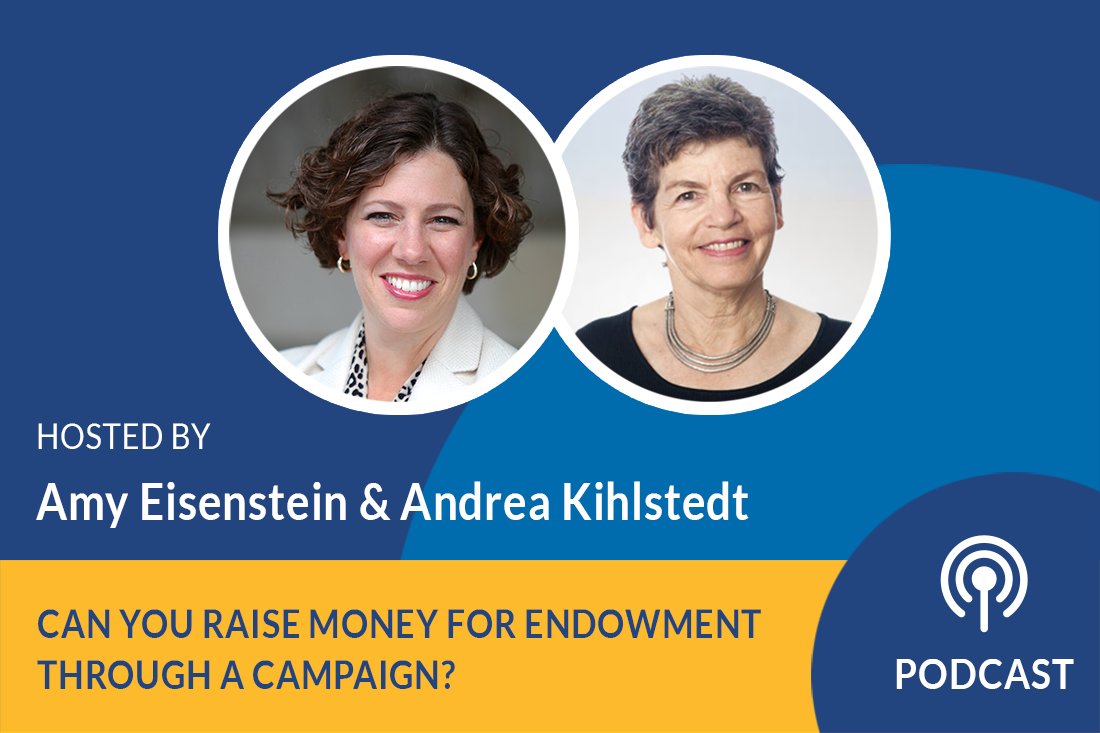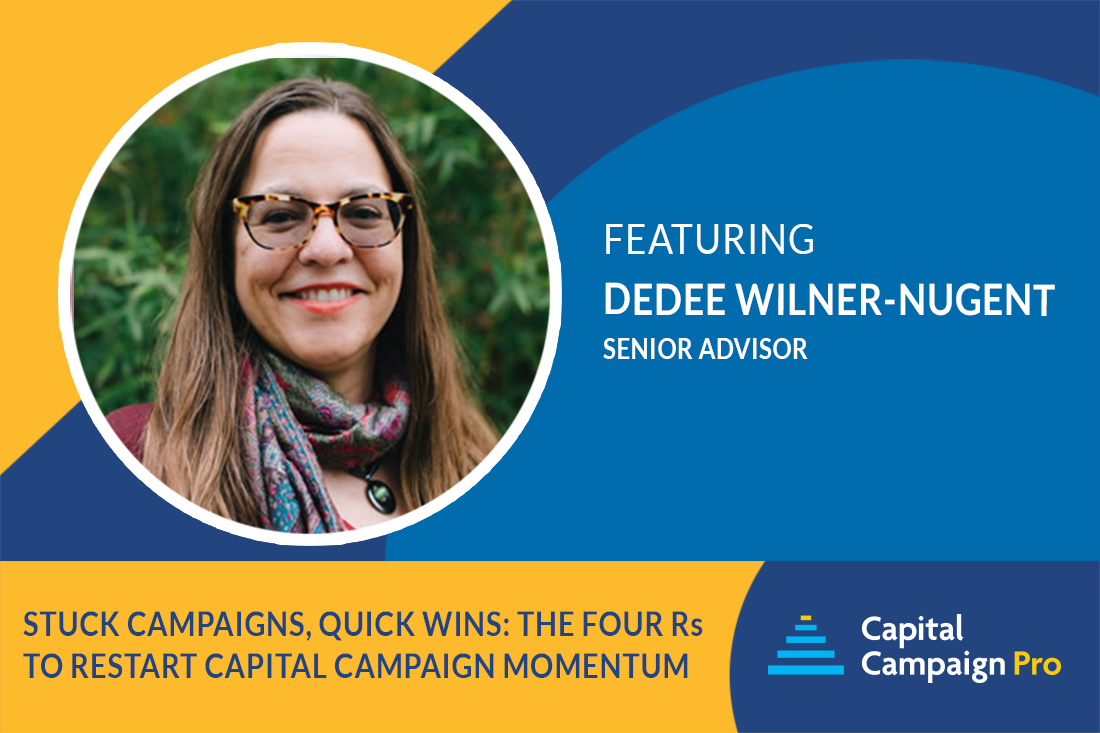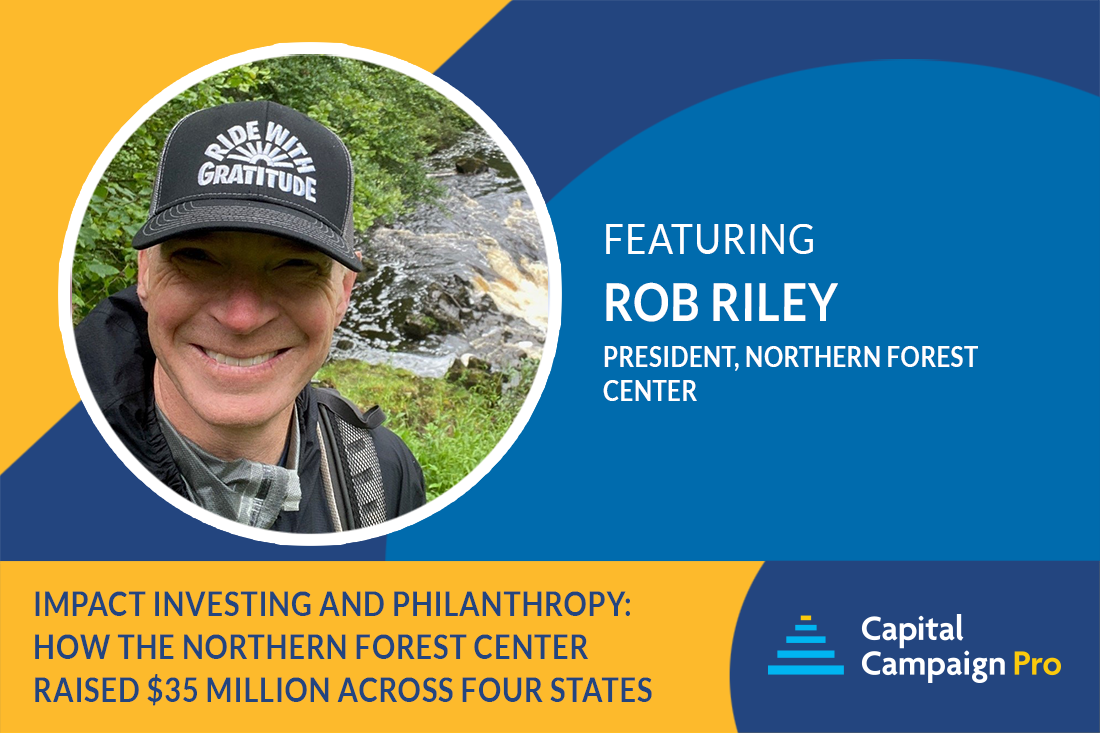Podcast: Can You Raise Money for Endowment Through a Campaign?

Season 3, Episode 19
Capital campaigns are not well suited for raising money for endowment. The most successful endowment fundraising is done through concentrated work on planned giving. That being said, most campaigns include a component of endowment. Amy and Andrea will unpack this complicated idea in this episode.
Listen Now:
Amy Eisenstein:
Are you well-endowed? Do you wish you could be? Or do you wish you were?
Hi, I’m Amy Eisenstein, and I’m here with my colleague and partner, Andrea Kihlstedt. And today we’re talking about endowments, something that every nonprofit wishes they were, well-endowed. So Andrea, why don’t we talk about endowments, specifically related of course, to capital campaigns, because so often organizations will come to us and say they want to do a capital campaign for endowment, and maybe they don’t say it, but the intention is:
“So we don’t have to fundraise. We want enough money in the bank that’s generating annual fund, operating money, so that we don’t have to fundraise again.”
That’s what boards think the goal is. So let’s talk about why that’s a good idea or a bad idea and what the trouble is.
Andrea Kihlstedt:
Yes. Well, and there are so many troubles with it, Amy, as you know.
When Endowment Takes the Place of Fundraising
So let’s start out with this. First of all, I think it’s a bad idea for organizations not to have to fundraise. I think it’s important for organizations to fundraise.
- It keeps them sharp.
- It keeps them relating to people.
- It keeps them understanding their mission and what’s important about it.
- It keeps them on their toes.
- It keeps them building relationships with people who can help them in significant ways.
So the very idea of trying to have a pot of money so you never have to fundraise again is just a wrong-headed notion.
Fundraising is Something You Should Want to Do
Fundraising is not onerous, is not something you have to do, but you really don’t want to do. Fundraising is a remarkable opportunity to build relationships with people, who want to help you, and by building those relationships and doing a good job of fundraising, the organization and you will be stronger. So let’s put that away.
Amy Eisenstein:
Well, first of all, it is onerous for many organizations, so don’t just say fundraising isn’t onerous. It is. And yet it is a important part of relationship building and community building for your organization.
I think the idea of not ever having to fundraise again, first of all, it’s unrealistic. And it’s not a good goal, to your point. I think. I mean, think of Harvard. They have a multi-billion-dollar endowment. They still have hundreds of fundraisers out talking to alumni, building relationships on the ground, fundraising every single day.
I think the notion that you can build an endowment large enough that you don’t have to fundraise anymore is sort of a silly one, and it’s bad for your organization because if you didn’t have to fundraise, then you would stop being community focused and talking to people in your community. So I think that’s, well, at least that’s my takeaway.
How Much of an Endowment to Cover Your Operating Budget?
Andrea Kihlstedt:
Now, let’s also get real about how much money you need to have in an endowment fund in order to generate a dollar for your operating budget. And the numbers are startling. Because let’s say that your endowment is generating 5% a year, you’re taking 5% out, which by today’s standards is high, but it’s a nice easy number. Let’s say it’s 5%. What that means is that for every dollar you generate from the endowment for your operating fund, you have to have $20 in your endowment. 20 times to generate 5% draw.
Now, that’s a little jarring. That means in order to generate $100,000 you need 20 times $100,000 in your endowment account. That’s a whole ton of money that just sits there. It sits there having minimal immediate results. And that means that a donor who’s going to give you out cash for that, a lot of cash, isn’t going to see very much positive benefit from the money that they’re transferring to you. It’s not exciting for most donors to give money to endowment.
Now, occasionally you do find a donor who is just committed to the idea of endowment. Every once in a while you find someone like that. But for the most part, donors are not excited to give to endowment. They’re excited to give in a way that sees that their money will have a more immediate impact. And endowment doesn’t have an immediate impact. It provides long-term stability, but not immediate impact.
Planned Giving and Endowment
So the biggest way for people to raise money for their endowment is through planned giving. And the most common way to do that is simply by getting people to include you in their wills. Now, that’s revocable. Sometimes people can say that you’re in their will and then you’re not. Sometimes they don’t tell you when you are, so it’s far less than certain to do it that way. But if you spend a fair amount of time getting people to include you in their wills, your organization over time will build its endowment through bequests, through legacy gifts. And that’s probably the best way to do it.
So why don’t people do that? By and large, because the money that will come in through legacy gifts is not going to come in on their watch. Chances are it’s going to be 10, 20, 30, 40 years before those gifts ever actually come in. So the person who’s done the work to build that planned giving relationship and to get someone to put you in their will isn’t going to see the result to their bottom line, to that fundraiser’s bottom line. It’s the next person or the person after that that’s all of a sudden going to get a windfall.
So, it’s hard to get development staff to focus on planned giving. The results aren’t immediate enough.
Endowment isn’t Exciting to Donors
Amy Eisenstein:
Right. So that’s why I think board members want to do a planned giving campaign or an endowment campaign sort of to focus there, but then you have these conflicting interests. Of course, the board wants to build the endowment, but if donors don’t want to give to the endowment, because as you said, it’s not exciting, and I think the other reality is that most people with wealth feel like they can manage their money long-term better than a nonprofit will, or can.
So they’d rather give the organization 50,000 a year for 10 years rather than a million today and have it sit there and generate 5%. They think donors, and in many cases they’re right, can manage their money better than a nonprofit will. And so they’re committed to giving to the annual fund and seeing that immediate impact and feel confident in doing that.
But the bottom line is endowment isn’t exciting to donors. And so the question I how do you balance those immediate needs and those long-term needs? And what we recommend to almost all of our clients is to do a campaign with multiple priorities and encourage donors to give now for the impending, present, current needs and the future of the organization, in addition to considering a planned gift, a legacy gift, leaving a bequest, that will build the endowment in the long term. And that’s the best of both worlds, honestly.
Andrea Kihlstedt:
Right. I mean, think about that again. If someone gives $50,000 a year to the annual fund, in order to do that through an endowment, they would have to give a million dollars to the endowment. Just keep that in mind. That’s just the reality of it. So yeah, many people don’t like to do that.
Amy Eisenstein:
Right. So let’s just emphasize that for a second. So are your $50,000 donors in reality, million-dollar donors?
In most cases, the answer is probably no. They don’t want to part with a million dollars. They feel like they can give $50,000 at this time. And so the idea that a $50,000 could or would give a million dollars is also unrealistic.
Including Endowment in Your Capital Campaign
Andrea Kihlstedt:
Right. But let’s talk about why we encourage people to include some endowment component in their campaigns. Because there are some very good reasons for that. Primary among them is that in a capital campaign, you will be talking to your largest perspective donors. And for some of those people, it will be an ideal time to ask them to give a cash gift or a pledged gift to the specific objectives of the campaign, the building, for example.
And to ask them if they would consider including your organization in their will or making a planned gift to your organization. You’re talking to them about their giving at a high level, and it’s an ideal opportunity to talk to them about a planned gift. That’s better done if one component of the campaign is endowment.
And one of the ways to do that, one of the ways I quite like, is that rather than having a dollar goal for the endowment in your campaign, you have what I think of as an activity goal. So it may be that your campaign is set out to raise $4 million for renovations of your building. And through this campaign, you want to get 20 people to include you in their wills.
Now, that doesn’t give a dollar amount of how much that money is going to amount to over time, but it does give an activity level, which is going to push everybody to talk to those donors about making a planned gift to the campaign. That’s a nice tidy way to do it. It’s very clean. It’s very clear.
“We want 20 new planned gifts in the context of this campaign.”
Everybody can count it. Everybody knows it. You can talk to donors about it. I like that.
Amy Eisenstein:
Yeah. And it’s much easier in terms of donor recognition too, because it’s not like you’re having to guess or having your donors predict, if they leave 5% of their estate, what dollar amount is that and when would it count if they don’t die for 10 or 20 years, if it doesn’t become realized for a long time into the future?
So counting and recognizing a new bequest intention in whatever way you’re going to recognize it is much easier than trying to guess at a dollar amount.
Andrea Kihlstedt:
Now, some organizations do want to put a dollar amount on the endowment, and that’s fine too. Then you just need to figure out how you’re going to value and count those dollars, when we know that these sort of fuzzy soft commitments in planned gifts. Many of them are fuzzy and soft. How are we going to go up about putting dollars on them?
You can develop some conventions for that if you want. You can say every planned gift, “Even if it doesn’t have a dollar amount, we are going to count at $50,000,” for example. You can just have some rules that you develop your campaign by.
Amy Eisenstein:
And if you want to get more complex about it, you can say, “The expectation of a 60 year old would come in at 50% and a 70 year old at 60%, a 70 year old at 80%,” or whatever. So there’s some age range metrics to consider as well when you’re thinking about planned gifts and when they might be realistically realized.
Donor Recognition Considerations
Andrea Kihlstedt:
The other area about endowment and capital campaigns, which is interesting and complicated, is how do you recognize someone in terms of naming opportunities or plaqueing when they have made both a cash gift or a pledge and a planned gift? And what will you do to acknowledge the planned gift when it comes to having a donor level, a recognition level? So that’s something you have to figure out.
I mean, you might say, for example, I’m not advocating this, but just to give you a way of thinking, you might say that you have naming opportunities at various levels. Those are based on cash gifts and pledges. And if someone has documented a planned gift to the organization that you will bump the level. You will bump the recognition level to the next higher level.
Amy Eisenstein:
That’s interesting.
Andrea Kihlstedt:
That would be one way to think about it that could be in your campaign policies. There may be other ways to think about it. Maybe there’s a separate naming opportunity for people who give planned gifts, for example, a separate plaque that they would be on maybe. So there are other ways to do it.
Maybe, as Amy said, if someone is giving a planned gift and there’s a cash amount of value assigned to that, you can then discount it according to age, as Amy was talking to, and add that to the gift, and then they get recognized in the naming opportunities at the higher level. That’s another possibility.
Amy Eisenstein:
Yeah.
Andrea Kihlstedt:
But you have to think it through.
Amy Eisenstein:
Yeah, it is complicated. So if your board comes to you and says:
“We want to do an endowment campaign.”
I strongly encourage you to have brainstorming session about what are the short-term and long-term needs of the organization. I mean, that’s what campaigns really are about. And do some strategic planning to see what can be funded in the shorter term, the next three to five years perhaps, that would really move the needle of this organization and have a simultaneous goal of growing your planned giving program and raising some serious dollars for the endowment in the longer term, but really helping dissuade them of this idea that an endowment only campaign is a good idea.
And I think that the one really clear way of doing that is making the case that all donors don’t want to give to your endowment. So it will be a exercise in futility of going to 10 donors and having nine of them say no to endowment. You want something else to offer them to give to.
And you can honestly test this with your board members. How many board members want to make significant and meaningful gifts to your endowment? And my guess is that most of them are going to hem and haw about that and not be enthusiastic about that. And so you can do a litmus test just with your board members and say:
“Alright, let’s see if this gets any legs.”
But really pushing them to come up with what are some other pillars, initiatives, whatever you want to call it. If you’re going to go to the trouble of doing a capital campaign, let’s raise as much money as we can now for these short and long term needs, in addition, and simultaneously, while we’re talking to all these big donors, talking about planned gifts and including bequests as well. So that in five, 10, and 15 years from now, we are growing our endowment in a significant and meaningful way.
A Word of Caution Regarding Endowment
Andrea Kihlstedt:
So we shouldn’t end this conversation, Amy, without sort of a word of warning.
If your organization doesn’t yet have an endowment, there is some work you have to do to get one set up. You can’t just take money in and pretend it’s an endowment.
- You actually have to figure out how the money is going to be invested and who’s going to manage that investment.
- You have to figure out what the policies are for that endowment. Can you take the principle out or can you not take the principle out?
- You have to figure out how you’re going to draw money out, at what rate you’re going to draw money out, and how you’re going to figure that out.
So you don’t just snap your fingers and have an endowment. You actually have to do some work, some homework, and some work to get a real endowment, or what’s called a quasi-endowment, a board restricted endowment, set up. So it’s set up in the right way, and it doesn’t just become part of your slush fund. And that’s super important for those of you haven’t done that yet.
Amy Eisenstein:
I think that’s great. So putting together an investment committee, a finance committee, and going to your local community foundation to get some advice and guidance is probably a great next step.
Alright. Excellent. So listen, here we are at Capital Campaign Pro saying don’t just do an endowment campaign no matter how much your board members want to. Really do some strategic thinking to do a campaign that has the goal of growing your endowment and other needs as well. It’ll be better for you, for your organization, and your donors.
Thanks for joining us today. We’re happy to have you here listening along with us. See you next time.



Leave a Comment